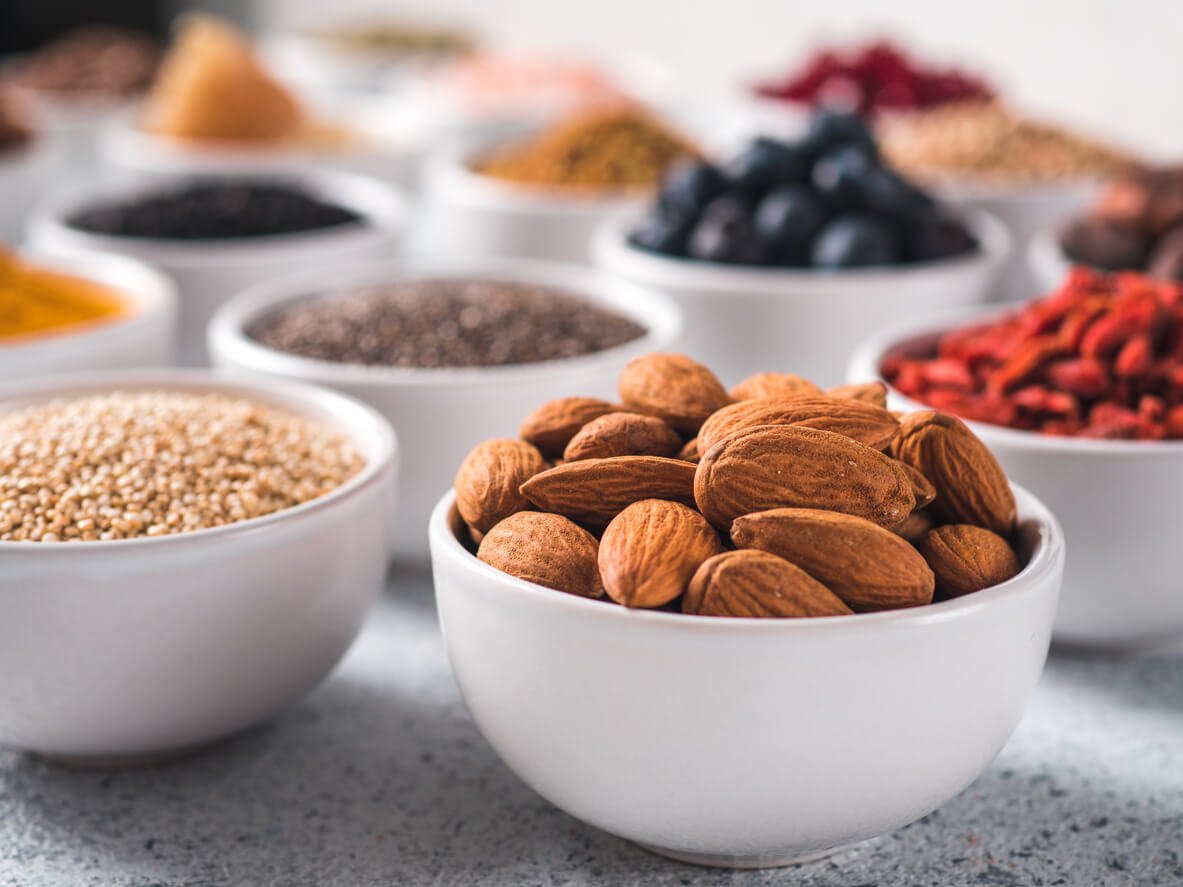Flavonoids are a type of phytonutrient, a term used to describe plant
chemicals that offer health benefits to the animals (including us) who eat them. They are members of the polyphenol category, which are bioactive compounds that, among other things, protect against oxidative stress and reduce inflammation.They were discovered in 1938 by Hungarian scientist Albert Szent-Gyorgyi, who tried to jump on the alphabet nomenclature train by calling them “Vitamin P.” (He’d had a good run already, having won the 1937 Nobel Prize in chemistry for his work isolating vitamin C.)
Flavonoids represent one of the most prevalent classes of compounds in fruits, vegetables, and plant-derived beverages like coffee and tea. While we generally only hear about a handful of them in articles or health-focused marketing for products that contain them, scientists have so far identified more than 6,000 flavonoids. Many of them are responsible for the attractive colors of flowers, fruits, and leaves.
While flavonoids are definitely a gift from the plant world to us, plants don’t produce them just to be nice to us. Their primary purpose is to offer plants innate protection against UV radiation that can damage them, pathogens that can make them sick, and herbivores that would otherwise eat them.
Types of Flavonoids & Where to Find Them

The main sources of flavonoids are a variety of plant-based foods, especially brightly colored fruits and vegetables. They’re also in herbs, spices, teas, chocolate, red wine, beans, whole grains, and nuts and seeds. If you eat a predominantly whole foods, plant-based diet, you’re pretty much guaranteed to be getting flavonoids on a regular basis.
Flavonoids fall into 12 major subclasses based on chemical structures, six of which are of dietary significance.
The six main types of flavonoids that you might find in your diet include:
1. Flavones
These flavonoids, which kind of sound like the name of a group of Motown backup singers, are widely present in the leaves, flowers, and fruits of plants as glucosides, a glucose derivative only found in plants. Examples of flavones include luteolin, apigenin, and tangeritin.
Among the major sources of flavones are celery, parsley, red peppers, chamomile, and mint, as well as the peels of citrus fruits, which contain tangeretin, nobiletin, and sinensetin (which are great words to know if you ever find yourself in a high stakes Scrabble game).
2. Flavonols
This is the largest and most studied subgroup of flavonoids in fruits and vegetables and includes compounds like kaempferol, quercetin, myricetin, and fisetin. Some of the richest sources of flavonols are kale, lettuce, tomatoes, apples, grapes, and berries. Additionally, alliums like onions, garlic, and scallions contain high amounts of quercetin. Tea and red wine (made, of course, from grapes) are also good sources.
3. Flavonones
These are found in all citrus fruits, like oranges, lemons, and grapefruits, as well as in their juices. Some of the most well-known examples of flavonones include hesperidin, naringenin, and eriodictyol.
4. Flavanols
Not to be confused with flavonols (couldn’t they have changed the name by more than one vowel?), flavanols include catechins and theaflavins. These are found abundantly in bananas, apples, blueberries, peaches, and pears. Catechins, in particular, are found in teas (particularly white, green, and oolong), cocoa-based products, grapes, berries, and apples — while theaflavins are primarily found in black teas.
5. Isoflavones
These are found in just a few types of plants, but exist in some microbes as well. Examples of isoflavones include daidzein, genistein, glycitein, biochanin A, and formononetin. They’re found in high amounts in legumes, especially soybeans.
6. Anthocyanidins
These are pigments responsible for colors in plants, flowers, and fruits — particularly ones that are red, blue, pink, and purple. The most common types of anthocyanidins include cyanidin, delphinidin, malvidin, pelargonidin, and peonidin (that’s a lot of dins — it must be pretty loud around those plants). You’re most likely to consume anthocyanidins (and anthocyanins, for that matter) in fruits like cranberries, black currants, grapes, raspberries, strawberries, blueberries, bilberries, and blackberries.
6 Health Benefits of Flavonoids

The wellness blogosphere resounds with chatter about how you should eat more flavonoids, but why exactly? Here are some of the most thoroughly researched benefits of including them in your diet.
1. They offer anti-inflammatory properties.
Flavonoids are champion inflammation-fighters. Inflammation is problematic because it’s an underlying factor in the development and worsening of many chronic diseases, including cardiovascular disease, cancer, type 2 diabetes, kidney and liver problems, and autoimmune and neurodegenerative disorders. In other words, inflammation is at the root of most of the things that kill us.
Some research suggests that flavonoids may be especially helpful in bringing down the inflammation that accompanies obesity, as they play an essential role in protecting against oxidative damage. Inflammation seen in obese individuals is often described as “meta-inflammation,” meaning an overall, systemic inflammation stemming from dysfunctioning fat tissue and excess nutrient intake that can be damaging to the overall health of the body.
Furthermore, flavonoids may help support normal autophagy, a process by which the body destroys and reabsorbs damaged, unhealthy cells that can make inflammation worse. Autophagy, which comes from the Greek words for “eats self,” — creates room for new, healthy cells to grow and thrive. Some research suggests that the flavonoid apigenin — found in large concentrations in parsley, celery, and chamomile — may have potential as a natural alternative therapy for chronic inflammatory conditions like cancer, type 2 diabetes, cardiovascular disease, and neurological disorders.
2. They may help protect your heart health.
Cardiovascular disease (CVD) is the leading cause of death worldwide (in humans, that is; muskrats, mosquitos, and marmosets probably have other things to worry about). Fortunately, flavonoids can aid in the prevention of CVD, thanks to their antioxidant and plaque-preventing characteristics. They may help lower unhealthy levels of blood fats, and prevent the oxidation of LDL “bad” cholesterol as well as the formation of dangerous blood clots.
In fact, one study suggests that consuming 100 mg per day of flavonoids may reduce the risk of coronary heart disease by nearly 10%. That’s an easy amount to get; for reference, one cup of blueberries delivers around 165 mg of flavonoids.
One flavonoid that appears to offer the most heart-protective activity is luteolin. Luteolin may help block oxidative stress that otherwise damages the heart, as well as help prevent the buildup of plaque in arteries that can lead to a heart attack or stroke.
You can find abundant luteolin in foods like broccoli, chamomile, peppermint, green peppers, parsley, dandelion, thyme, carrots, olive oil, celery, oregano, rosemary, and oranges.
3. They’re good for your brain.
Flavonoids may also positively affect the health of your brain. They appear to directly interact with what’s called the glyoxalase pathway, a cellular pathway with especially important functions in your brain. When it is impaired, it can severely threaten brain health, even triggering the progression of neurodegenerative diseases like Parkinson’s and Alzheimer’s, and speeding up the cognitive effects of aging.
How do flavonoids help your brain? Researchers say they help protect neurons from toxins, reduce brain inflammation, and even improve learning, memory, and cognitive function. They may also have neuroprotective benefits that may be specific to the seizure disorder epilepsy, which affects around one percent of the general population. Some studies have observed that flavonoids like rutin, quercetin, luteolin, and hesperidin bind the GABA receptors in the brain and subsequently offer anticonvulsant effects.
Improving Cognitive Function
In a 2020 study published in the journal Nature, researchers found that flavanols improved brain function and improved oxygenation levels in the brain in response to a stressful event. The study was kind of cool, so I’ll describe it in some detail.
Participants drank a cocoa-containing beverage, then breathed air with a carbon dioxide concentration 100 times higher than found in regular air, which reduced oxygen availability in their brain and body. Then, they completed a bunch of cognitive tests of increasing difficulty — all variants of the “Stroop test” in which you see a word like “red” typed in blue ink and have to name the color of the word rather than read it. It’s hard — you can test yourself here. And then imagine how hard it would be with a loopy, oxygen-deprived brain.
But remember that cocoa drink? On one occasion, it was quite low in flavanols — a negligible amount, really. On a second occasion, it was chock-full of flavanols. And the study was double-blinded, so neither the participants nor the researchers knew the concentration of each brew. It turned out that those who drank the high-flavanol beverage completed the Stroop tests at higher speed and accuracy.
Overall, the study confirmed that flavanols found in foods like cocoa help to protect against vascular diseases, likely by improving nitric oxide signaling and supporting endothelial health.
4. They may offer anticancer benefits.
Flavonoids may help work against cancers in a few ways. First, they have strong antioxidant capabilities, helping protect your cells from oxidative damage that can lead to cancerous mutations. They also play a role in inducing cancer cell death and suppressing the spread and invasiveness of unhealthy cells. In other words, while they act as antioxidants in your body’s healthy cells, flavonoids act as pro-oxidants in cancer cells.
5. They may help strengthen your bones.
Eating an array of flavonoids may also support your skeletal health. Research shows that flavonoids may help prevent osteoporosis, a degenerative bone disease characterized by the softening of bones that puts people at a much higher risk for fractures and breaks.
And a 2016 review published in the Journal of Investigative Medicine examined the effects of tea flavonoids on human and animal bone health. The authors found that even moderate intake of tea can be helpful for supporting bone strength, and recommend further research on the combination of flavonoids in conjunction with bone-promoting nutrients like calcium and vitamin D.
6. They may help support healthy blood sugar control.
Eating flavonoid-rich foods may also help lower your risk for developing type 2 diabetes, according to research out of the United Kingdom. Nutrition researchers at the University of East Anglia’s Norwich Medical School found that women who consumed a diet high in flavonoids had lower risk for inflammation and insulin resistance, which are precursors to diabetes.
The average daily intake of total flavonoids was 1.2 grams per day among the nearly 2,000 study participants, which primarily came from tea, followed by grapes, pears, wine, berries, oranges, and peppers. And women who ate anthocyanins and flavones, in particular, had the least insulin resistance and the lowest levels of inflammation.






Комментариев нет:
Отправить комментарий